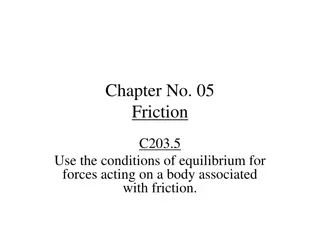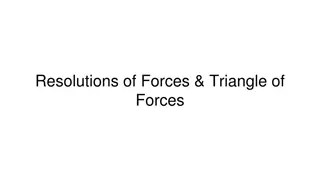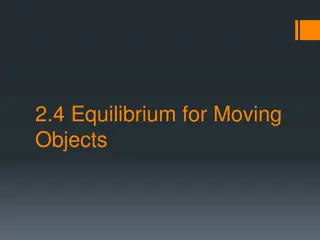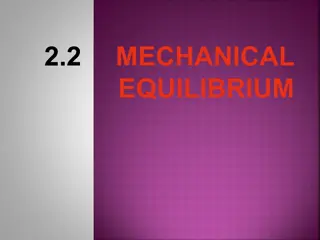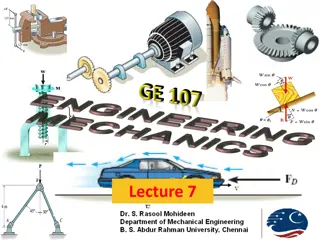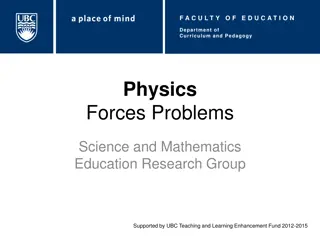Understanding Forces and Equilibrium in Physics
Forces in physics can be categorized into contact forces and field forces, measured in units like Newtons (N). Inertia, mass, weight, and equilibrium are fundamental concepts in understanding the behavior of objects under different conditions. An object in motion stays in motion unless acted upon by an external force, while systems at rest or moving at a constant speed are in equilibrium when all forces balance out. Resolving forces into components and solving for unknowns are key strategies in analyzing force interactions.
Download Presentation

Please find below an Image/Link to download the presentation.
The content on the website is provided AS IS for your information and personal use only. It may not be sold, licensed, or shared on other websites without obtaining consent from the author. Download presentation by click this link. If you encounter any issues during the download, it is possible that the publisher has removed the file from their server.
E N D
Presentation Transcript
Unit is the NEWTON (N) 1 N = 1 kg m/s2 Is by definition a push or a pull Two types of forces: Contact Forces exist when two objects are in contact: tension, friction, applied force, etc. Field Forces (aka Long Range Force) no physical contact gravitational, electric, magnetic, etc.
INERTIA a quantity of matter, also called MASS. Italian for LAZY . Unit for MASS = kilogram. Weight or Force due to Gravity (Fg) is how your MASS is effected by gravity. = = g= = W F mg NOTE: MASS and WEIGHT are NOT the same thing. MASS never changes When an object moves to a different planet. What is the weight of an 85.3-kg person on earth? On Mars=3.2 m/s2)? W mg W 3 . 85 ( = = = = ) 8 . 9 )( 3 . 85 ( = 835 94 . N ) 2 . 3 )( 272 96 . W N MARS
An object in motion remains in motion in a straight line and at a constant speed OR an object at rest remains at rest, UNLESS acted upon by an EXTERNAL (unbalanced) Force. There are TWO conditions here and one constraint. Condition #1 The object CAN move but must be at a CONSTANT SPEED Condition #2 The object is at REST Constraint As long as the forces are BALANCED!!!!! And if all the forces are balanced the SUM of all the forces is ZERO. The bottom line: There is NO ACCELERATION in this case AND the object must be at EQILIBRIUM ( All the forces cancel out). = = 0 0 acc F
A pictorial representation of forces complete with labels. FN Weight(mg) Always drawn from the center, straight down Force Normal(FN) A surface force always drawn perpendicular to a surface. Tension(T or FT) force in ropes and always drawn AWAY from object. Friction(Ff)- Always drawn opposing the motion. FT Ff FT W1,Fg1 or m1g m2g
FN Ff Fg
Fx = 0 FNx + -Ffx = 0 FNx = Ffx (but in opposite directions) FN Ff Resolving Angled Vectors into their Component Vectors FNy Ffy AND FNx Ffx Fy = 0 FNy + Ffy + -Fg= 0 FNy + Ffy = Fg (but in opposite directions) Fg
Since the F = 0 (in both x and y directions) , a system moving at a constant speed or at rest MUST be at EQUILIBRIUM. TIPS for solving problems Draw a FBD Resolve all angled force vectors into COMPONENTS Write equations of equilibrium Solve for unknowns
A 10-kg box is being pulled across the table to the right at a constant speed with a force of 50N. a) Calculate the Force of Friction = = b) Calculate the Force Normal F = = 0 x = = F F N 50 f app FN = 0 F = y Fapp Ff F F N g = = 2= 10 ( )( 10 / ) 100 F mg kg m s N mg n
Suppose the same box is now pulled at an angle of 30 degrees above the horizontal. a) Calculate the Force of Friction = = F = = 0 x F F f app x b) Calculate the Normal Force = = = = F F 43 cos 50 cos 30 f app 3 . = = F mg = N f ! F N FN Fapp 0 F + y = F F F Fappy Ff N app g y 30 = F mg F N app Fappx y = 2 10 10 ( / ) 50 sin 30 F kg m s mg N = 75 F N N
If an object is NOT at rest or moving at a constant speed, that means the FORCES are UNBALANCED. One force(s) in a certain direction over power the others. THE OBJECT WILL THEN ACCELERATE.
The acceleration of an object is directly proportional to the NET FORCE and inversely proportional to the mass. 1 = = Fnet F a F AND a net m F = = = = net a F ma net Tips: Draw an FBD Resolve force vectors into components Write equations of motion by adding and subtracting vectors to find the NET FORCE. Always write larger force smaller force. Solve for any unknowns m
A 10-kg box is being pulled across the table to the right by a rope with an applied force of 50N. Calculate the acceleration of the box if a 12 N frictional force acts upon it. In which direction, is this object accelerating? = = F ma net = = F F ma FN app f The x-direction! F F Ff Fapp app f = = a m So N2L is worked out using the forces in the x-direction only 50 12 mg = = a 10 = = 2 a m s 8 . 3 / NOTE: In the y- direction, the box obeys N1L
A mass, m1 = 3.00kg, is resting on a frictionless horizontal table is connected to a cable that passes over a pulley and then is fastened to a hanging mass, m2 = 11.0 kg as shown below. Find the acceleration of each mass and the tension in the cable. m F netblock 1 = = = = a = = F m = = a 1 netblock 2 2 F m a FN m g F m a T 1 T 2 2 FT = = m g m a m a 2 1 2 FT = = + + m g m a m a 2 2 m 1 = = + + m g a m ( ) m1g 2 2 1 m + + g = = 2 a m m 1 2 ) m2g 11 ( )( 10 2 = = = = a m s . 7 86 / 14
= = 2 Fnet ma = = = = T kg 6 . 23 m s 3 . 7 ( 86 / ) m g T m a = = T N 2 2 and = = T m a 1 = = F ma net 6 Slope = F 4 = = m NET 2 F a 0 Rise 1 2 A 3 4 = = Slope Run



